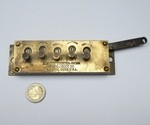
Description
Video
History
Articles
Advertisements
Patents
Links
This is a 5-digit counter. It is intended for industrial use, and was often used with printing presses and in the textile industry. It could be connected to an industrial machine in order to count how many cycles were done, e.g. how many items were produced. There is a lever on the right hand side, and pushing it down increments the counter.
It is a rectangular brass box, held together by screws in the corners on the front and back. The five digits of the register are visible through small round windows in the front plate. Below each window is a knob with which the digit can be changed. The number is reset by setting the digits from right to left.
This counter has seen so much use that it is worn out. The attachment hole in the lever has expanded to almost reach the edge. The axle hole in the rear plate for the units wheel has expanded so much that the carry mechanism fails if more than two digits carry over.
The mechanism is very simple. The axles are tilted slightly so that the number wheels can overlap and be at the same depth in the windows. They rotate in alternate directions so that the carry mechanism can remain simple, without intermediate wheels.
Here is a video where I show the Elm City Counter.
The Elm City Printers' Warehouse was a printer supply store in New Haven, Connecticut. New Haven has the nickname Elm City due to the large number of Elm trees there. This store was founded in 1876 by H. P. Hubbard, but changed hands fairly often. In 1882 it was bought by George David Read Hubbard. It was located at 379 State Street.
The first mention I found of the Elm City Counter is from 1883. George Hubbard sold all kinds of printer supplies and printing services, but also manufactured a number of his own products made from brass and steel, including a card cutter and the Elm City Counter.
In late 1887 the store and the manufacturing rights of the store's own products was purchased by George E. Ives. This lasted till 1891, when the business was continued by G. Edward Osborn (& Co). The business went bust in 1894. It is possible that the manufacturing of the Elm City Counter was outsourced to the factory of Charles J. Root in Bristol, Connecticut.
Joel H. Root began to make clock trimmings in Bristol in the 1850s, and managed to grow his business such that he set up a factory in about 1865 where he also made piano hinges. When he died in 1885, his son Charles took over the business. He diversified into making counters, registering a patent for a counter mechanism in 1891. It is unclear in what way this patent differs from the previously produced Elm City counters. This mechanism was used in Root's Bristol Counter, and it seems quite plausible that Root's factory also produced the Elm City Counter for G. Edward Osborn, too.
Charles J. Root also made hinges for car manufacturers, and became an avid car enthusiast. This sadly led to his death in 1907, when he and his family were killed when his steam-powered car (a Stanley Steamer) collided with a train. The factory and other business assets were bought by a local syndicate, which formed the C. J. Root Company to continue the business. It advertised its counters especially to the textile trade, but also continued to make hinges, and offered metal stamping and electroplating services to other businesses.
The C. J. Root Company made several versions of the Elm City Counter. It was available with 2, 3, 4, 5, or 6 digits; it could be supplied with a bell that rang when the register overflowed, with a key instead of setting knobs, or with a locking bar that covered the setting knobs completely to completely block unauthorized changing of the digits.
In 1920 the company shortened its name to The Root Company, and in 1928 it merged with Veeder, another company that made small counters, to become Veeder-Root. This new company continued to make Elm City Counters in all variations with only the front inscription changed, until at least the late 1930s. The Veeder-Root company became almost synonymous with mechanical counters.
| 1882-1887 | G. D. R. Hubbard |
|---|---|
| 1887-1891 | George E. Ives |
| 1891-1894 | G. Edward Osborn (& Co) |
| 1895-1907 | C. J. Root (No Elm City Counters known) |
| 1908-1920 | The C. J. Root Company |
| 1921-1928 | The Root Company |
| 1928- | Veeder-Root, Inc. |
Here are various articles of this counter that I found in online archives.
Here are various advertisements and catalogue listings from online archives. The drawings of the older Elm City Counters have the setting knobs all arranged in a straight line, but physical examples of the counter, even earlier ones by G.D.R. Hubbard, actually seem identical to later versions with the knobs arranged in a zig-zag fashion.
The inscription on the front of the counter lists a 1891 patent which is by Charles J. Root. I have not found any patents for the older version of the Elm City Counter.
| Patent | Filing date | Priority date | Name | Description |
|---|---|---|---|---|
| US 450,039 | 27-10-1890 | 07-04-1891 | Charles J. Root | Counter-register |
© Copyright 2021 Jaap Scherphuis, mechcalc a t jaapsch d o t net.